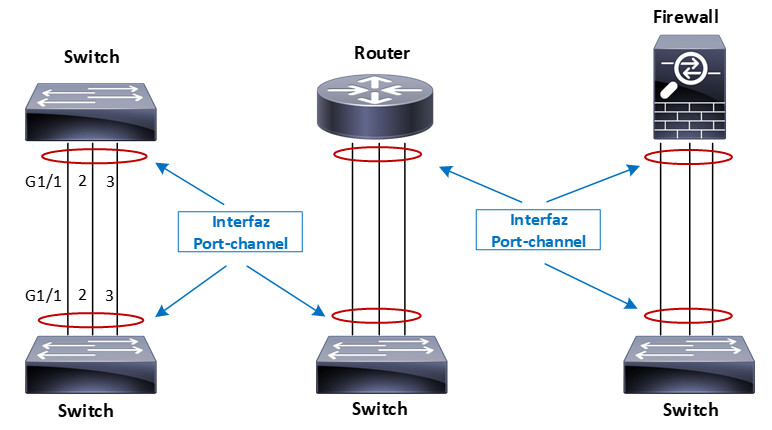Etherchannel, also known as Link Aggregation, is a technology that allows grouping several physical interfaces that connect a pair of devices; when the etherchannel is established, the devices see it as a single logical interface, increasing the bandwidth considerably.
Up to eight physical interfaces can be grouped into a single logical interface; this new logical interface is called Port-Channel. EtherChannel ports can be configured at Layer 2 or Layer 3.
EtherChannel provides high-speed, fault-tolerant links between switches, routers, firewalls, and servers. If a link fails, EtherChannel redirects traffic from the failed link to the remaining links in the port-channel without administrative intervention and is transparent to the end-user.
The control plan protocols consider the logical port-channel interface and not the individual interfaces that comprise them, e.g., Spanning-Tree.

For etherchannel to work, both devices must understand and use the technology to function correctly.
Generally, all ports grouped must first belong to the same VLAN. If used as a trunk, the trunked ports must be in trunking mode, have the same native VLAN, and pass the same VLAN set. Each port must have the same speed and duplex configuration before grouping. The bundled ports must also have identical spanning-tree configurations.
The port-channels to be used at layer 3 must be configured with the no switchport command.
Port-channel load balancing
The distribution of frames between the physical interfaces that make up the port-channel is based on a hashing function. This hash depends on the method used for load balancing. The result obtained from the hash identifies which physical port will be used to send the frame.
The hashing operation can be performed on MAC or IP addresses and can be based only on the source address, destination address, or both (some methods use the port number). The default load-balancing methods depend on the model and software version of the switch; they can be layer 2, 3, or 4 and apply globally to all port-channels. Let’s look at some of the available etherchannel balancing methods:
- src-ip : Source IP address
- dst-ip : Destination IP address
- src-dst-ip : Source and destination IP address
- src-mac : Source MAC address
- dst-mac : Destination MAC address
- src-dst-mac : Source and destination MAC address
- src-port : Source port number
- dst-port : Destination port number
- src-dst-port : Destination source port number
The configuration of the balancing method is with the following command:
Switch# port-channel load-balance <method> ! Example: Each platform provides some extra methods Switch# port-channel load-balance ? dst-ip Dst IP Addr dst-mac Dst Mac Addr dst-mixed-ip-port Dst IP Addr and TCP/UDP Port dst-port Dst TCP/UDP Port mpls Load Balancing for MPLS packets src-dst-ip Src XOR Dst IP Addr src-dst-mac Src XOR Dst Mac Addr src-dst-mixed-ip-port Src XOR Dst IP Addr and TCP/UDP Port src-dst-port Src XOR Dst TCP/UDP Port src-ip Src IP Addr src-mac Src Mac Addr src-mixed-ip-port Src IP Addr and TCP/UDP Port src-port Src TCP/UDP Port vlan-dst-ip Vlan, Dst IP Addr vlan-dst-mixed-ip-port Vlan, Dst IP Addr and TCP/UDP Port vlan-src-dst-ip Vlan, Src XOR Dst IP Addr vlan-src-dst-mixed-ip-port Vlan, Src XOR Dst IP Addr and TCP/UDP Port vlan-src-ip Vlan, Src IP Addr vlan-src-mixed-ip-port Vlan, Src IP Addr and TCP/UDP Port Switch(config)#
Command to see the method of balancing that a switch has:
Switch# show etherchannel load-balance EtherChannel Load-Balancing Configuration: src-dst-ip EtherChannel Load-Balancing Addresses Used Per-Protocol: Non-IP: Source XOR Destination MAC address IPv4: Source XOR Destination IP address IPv6: Source XOR Destination IP address Switch#
To verify how effectively a configured load balancing method is running, you can use the show etherchannel port-channel command. Each link in the channel is displayed, along with a hexadecimal “Load” value. Although this information is not intuitive, you can use the hexadecimal values to get an idea of the traffic loads of each link relative to each other.
Switch# show etherchannel port-channel Channel-group listing: ----------------------- Group: 10 ---------- Port-channels in the group: ---------------------- Port-channel: Po10 (Primary Aggregator) ------------ Age of the Port-channel = 1344d:00h:15m:03s Logical slot/port = 14/2 Number of ports = 2 HotStandBy port = null Port state = Port-channel Ag-Inuse Protocol = LACP Port security = Disabled Fast-switchover = disabled Fast-switchover Dampening = disabled Load share deferral = disabled Is fex host PO = FALSE Ports in the Port-channel: Index Load Port EC state No of bits ------+------+------------+------------------+----------- 0 8E Te5/1 Active 4 1 71 Te5/2 Active 4 Time since last port bundled: 287d:08h:41m:08s Te5/2 Time since last port Un-bundled: 287d:10h:48m:10s Te5/2
When a port-channel goes to the errdisable state, it is necessary to power down and power up the port-channel interface and the individual physical interfaces.
The following post will discuss the existing protocols for establishing etherchannel links.
For more information: